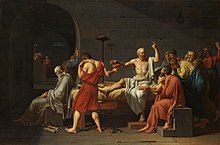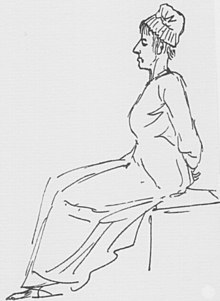Jacques-Louis David



Jacques-Louis David (born August 30, 1748 in Paris , † December 29, 1825 in Brussels ) was a French history painter of classicism .
life and work
His work is divided into three epochs. As court painter to the French royal family and member of the French academy , he created numerous pictures with ancient motifs . David adopted the gestural pathos of many of his characters from Jean-Baptiste Greuze .
David was first a student of Joseph-Marie Vien . In 1771 he took part in the competition for the Prix de Rome with the image Mars fighting with Minerva . In 1774 he was awarded the first prize of the Prix de Rome , a grant for a multi-year stay in Rome, for his painting The Doctor Erasistratos Discovers the Cause of Antiochus' Disease . David traveled to Rome with his teacher, where he moved as director of the Académie de France à Rome .
In Rome, David devoted himself to the study of antiquity , Michelangelo and Raphael , with Raphael particularly stimulating his ambition. Besides seemed Guido Reni and Domenichino at him. These various influences can also be seen in his first painting, St. Roch with the plague sufferers in front of the Madonna, completed in 1779 .
After he returned to Paris in 1781, he exhibited a Belisarius (Musée des Beaux-Arts, Lille) in 1783 and a mourning Andromache in 1784 , which won him admission to the Académie royale de peinture et de sculpture . On behalf of the king he painted the oath of the Horatians (1784, in the Louvre), which had great success in the Salon de Paris of 1785. For this picture David had made new studies in Rome. The style of the paintings La Mort de Socrate (1787) and Brutus, to whom the corpses of his sons are brought into the house (1789, in the Louvre, where the Les Amours de Pâris et d'Hélène painted in 1788 is also located) moved in the same direction. .
After the revolution began , David became politically active and influenced French painting. On behalf of the Legislative Assembly, he began the oath in the Ballhaus , a gigantic composition that has remained unfinished (in the Louvre ). As a staunch republican, he became a member of the Corps électoral of Paris and convent deputy in 1792 and, as such, voted for the execution of King Louis XVI.
David used his position as MP and member of the National Convention to preserve much in those times of the overthrow of so many art institutes. On the other hand, he operated the abolition of the academy. It was in his power to prevent the destruction of many works of art; but he failed to do so because he did not recognize any of the many old monuments of painting, sculpture and architecture as good, but wanted to create from scratch here too.
As a Jacobin and friend of Maximilien de Robespierre and Jean Paul Marats , he also exerted significant influence on the Security Committee ; but this had the consequence that he was involved in Robespierre's fall ( 9th Thermidor ) and was imprisoned. He was saved by the amnesty of October 26, 1795 and the efforts of his students and admirers. During these eventful experiences, he completed two realistic paintings, the death of Lepelletier de Saint-Fargeau and the death of Marat. In his picture The Death of Marat , which he painted in 1793 on behalf of the convention, David stylized Jean Paul Marat, who had just been murdered, as a political martyr of the revolution. It now hangs in the Royal Museums of Fine Arts in Brussels. Much simpler in execution, but hardly less famous, is David's pen drawing, also made in 1793, with the depiction of the former Queen Marie Antoinette on the way to her execution on October 16, 1793. The design for his Sabine women , which he executed in 1799 and was created in prison which is now in the Louvre.
Ultimately, Napoleon's seizure of power offered a new chance and thus the beginning of a new era for David. The monumental painting The Coronation of Napoleon I and Empress Josephine in the Notre-Dame Cathedral in Paris on December 2nd, 1804 ( Sacre de l'empereur Napoléon Ier et couronnement de l'impératrice Joséphine dans la cathédrale Notre-Dame de Paris, le 2 décembre 1804 ) was created in 1806/1807. The picture was hung in the government palace in 1808 and is also in the Louvre. In the period that followed, many Napoleon portraits and battle pictures were created.
During Napoleon's reign, David glorified the deeds and celebrations of the empire in his pictures. David's main works from that period are Napoleon on horseback, sprinkling up St. Bernhard ( Museum at Versailles , Berlin Palace, Blücher's trophy), Napoleon's coronation (Louvre, called le sacre ), Napoleon in imperial robe , The distribution of the eagles 1810 (Museum in Versailles), Das Fest auf dem Stadthaus etc. In 1814 he also created Leonidas in Thermopylae (in the Louvre), the portrait of Pius VII and the portrait of Madame Récamier (Louvre) stretched out on a couch .
With Napoleon, David's lucky star also went under in France. As a "regicide" he was removed from the list of members of the institute in 1816 and banned from France. An invitation from the King of Prussia - Friedrich Wilhelm III. - to Berlin, where he was to take over the management of all the art establishments, he turned down and moved to Brussels, in order to stay at least near France. Here, despite his age and other misfortunes, he continued to paint, exhibiting the resulting paintings in Ghent, Brussels and some in Paris, but could not be persuaded to seek the grace of the King of France, Louis XVIII. , to win.
His last larger paintings are The Wrath of Achilles (1819), Mars disarmed by Venus and the Graces , Amor and Psyche and The Farewell of the Nymph Eucharis by Telemach (1820).
David died in Brussels on December 29, 1825 and was buried in the Evere cemetery near Brussels, except for his heart, which was buried in the Père Lachaise cemetery in Paris (see heart burial ).
The number of his works is very great; many paintings are in the Louvre and the Palace of Versailles. In German-speaking countries, Napoleon can be seen on the Great St. Bernhard in the Belvedere in Vienna , the Marquise de Sorcy de Thélusson in 1790 as a portrait in the Neue Pinakothek in Munich , which she is still single and in her private, unofficial appearance.
In 2012, up to $ 7 million was paid in the art market for one of his oil paintings.
Awards
- 1774: Prix de Rome
- 1784 [?]: Member of the Académie royale de peinture et de sculpture
student
David trained over 400 students, including Antoine-Jean Gros , Jean-Baptiste Debret , François Gérard , Germain-Jean Drouais , Anne-Louis Girodet-Trioson , Jean-Auguste-Dominique Ingres , Johann Peter Krafft , Alexandre Abel de Pujol , Michel-Martin Drolling , Jean Victor Schnetz , Johann Baptist Joseph Bastiné , Robert Lefèvre , Jacques-Laurent Agasse and Pieter Van Hanselaere are the most important. David has had a long-lasting influence on modern French painting. He also laid the foundation for the solid technical education, which is a major asset of the French school. He also created something lasting in a number of portraits based on a naturalistic view, independent of his antiquing tendency. In connection with the French Revolution and the Napoleonic era, it was of epoch-making importance in the field of fine arts.
literature
- Jacques L. David (David's grandson): Le peintre Louis David Souvenirs et documents inédits. Victor-Harvard, Paris 1882.
- Marion Diez (Ed.): Jacques-Louis David, 1748–1825. Chandus, Paris 2005, ISBN 2-35039-012-8 .
- Hubertus coal : The Road from Rome to Paris. The Birth of a Modern Neoclassiscism. In: Dorothy Johnson (ed.): Jacques Louis David. New Perspectives. University of Delaware Press, Newark DE 2006, ISBN 0-87413-930-9 , pp. 71-80.
- Ewa Lajer-Burcharth: Necklines. The art of Jacques-Louis David after the terror. Yale University Press, New Haven CT et al. 1999, ISBN 0-300-07421-2 .
- Klaus Lankheit : The death of Marat. Jacques-Louis David (= work monographs on the fine arts in Reclam's Universal Library. 74, ZDB -ID 2267951-0 = Universal Library. B 9074). Reclam, Stuttgart 1962.
- Warren E. Roberts: Jacques-Louis David, revolutionary artist. Art, politics and French revolution. University of North Carolina Press, Chapel Hill NC et al. 1989, ISBN 0-8078-1845-3 .
- Elmar Stolpe: Classicism and War. About the history painter Louis David. Campus-Verlag, Frankfurt am Main et al. 1985, ISBN 3-593-33488-7 .
Web links
- Literature by and about Jacques-Louis David in the catalog of the German National Library
- Works by Jacques-Louis David at Zeno.org .
- Jacques-Louis David at Google Arts & Culture
- Web Gallery of Art
- Works by David in French museums , Base Joconde database
References and footnotes
- ^ Saint Roch intercédant la Vierge pour les malades de la peste , today in the Musée des beaux-arts in Marseille .
- ↑ freely translated: Socrates, drinking the cup of poison . The painting is in the Metropolitan Museum of Art , New York, Europe in the Age of Enlightenment and Revolution. ISBN 0-87099-452-2 , p. 11.
- ↑ Original title: Les licteurs rapportent à Brutus les corps de ses fils
- ↑ A practically identical picture hangs in the Palace of Versailles (salle du Sacre).
- ↑ Original title La Colère d'Achille .
- ↑ Mars Desarme par Venus et les grâces (1824), Royal Museums of Fine Arts de Belgique.
- ↑ today in the Cleveland Museum of Art
- ↑ Original title: Les Adieux de Télémaque et d'Eucharis .
- ↑ Information on the website of Christie's auction house , accessed on August 24, 2012.
- ↑ online .
| personal data | |
|---|---|
| SURNAME | David, Jacques-Louis |
| BRIEF DESCRIPTION | French painter |
| DATE OF BIRTH | August 30, 1748 |
| PLACE OF BIRTH | Paris |
| DATE OF DEATH | December 29, 1825 |
| Place of death | Brussels |





